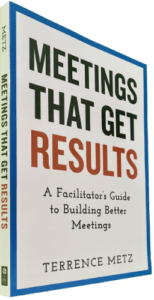Accurate estimating for meeting duration helps optimize the schedules and expectations of your participants. Therefore, stay vigilant. When estimated incorrectly, your sessions risk the worst deliverable from any meeting — another meeting.
Poor estimating also leads to poor-quality deliverables. Additionally, if your meeting duration expands, expect scheduling challenges from people and facilities (room availability) and critically — erosion of your facilitator’s credibility.
General Guidelines for Estimating Meeting Duration
Complete meetings within fifty minutes unless your meeting focuses on information updates, such as a staff meeting or daily scrum — then limit the meeting to fifteen minutes, standing up. Time limits ensure that participants do not become frustrated or exhausted. Likewise, consistency encourages more reliable and prompt attendance for the meetings you facilitate.
Schedule your meetings to begin at five past the hour or half hour. Conclude within fifty minutes, typically five minutes before the hour or half-hour. In other words, be the one session leader courteous enough to allow your participants time between meetings (i.e., back-to-backs) to check their email, grab some coffee, etc.
Estimating Workshop Duration
As a general rule, schedule workshops for no more than two (or three) days in length, although Design Sprints and Hot Washes (aka Lookbacks or Post Mortems) will run up to five days.
The workshop is the ultimate time-box—that is, work expands or contracts to fill the time allotted. Therefore, Guesstimate how long each agenda step takes. After that, add up your times. When they total between sixteen and twenty-five hours, make it a three-day workshop. If less, make it a two-day (or partial) session. If more than thirty hours, you are better off scheduling two sessions (unless participants are subject to substantial travel time and costs).
Office politics, poor workshop environment (physical), lack of clear workshop definition or meeting purpose, and characteristics of the project all affect the risk of on-time completion.
12 PMI (Project Management Institute) Planning Steps Applied to Managing Multiple Workshops
- Define the scope and list project phase deliverables needed
- Identify checkpoints in the process
- Determine business function and personnel involvement
- Identify workshop deliverables and agendas
- Identify approaches and procedures required
- Schedule opening and closing sessions
- Develop schedules and organize sessions so they feed information properly
- Schedule participants
- Match facilities and session leaders
- Schedule preparation time
- Finish schedule and apply calendar dates
- Adjust as needed
-
IDENTIFY PRODUCT OR PROJECT DELIVERABLES
The purpose of this step is to identify the products produced by the project. Product or project deliverables define the expected output of the workshops—the session deliverables. Consequently, the project deliverables indicate the needed type of workshop and who participates.
- List the project deliverables (e.g., requirements document) needed for the phases included in the facilitated efforts.
- Organize these chronologically and into logical groupings.
- Define or obtain an example of what the session deliverable should look like to support the project deliverables.
-
ID CHECKPOINTS
The identification of checkpoints is often the easiest way to partition workshops and their session deliverables. This partitioning helps you schedule workshops based on the output expected rather than forcing a workshop based on a methodology or life cycle. Therefore, this second step of partitioning often defines the number and types of workshops required.
- Identify logical checkpoints in the process.
- Often these checkpoints include a walk-through or phase review. These identify when to review deliverables.
-
DETERMINE BUSINESS FUNCTIONS
This step adds the second of four variables—participant resource availability—to the planning process. It validates the groupings completed in steps one and two as well as provides a functional partitioning for the identification of workshops.
- Identify the business areas, functions, and people (potential participants) required to or involved in producing each of the session deliverables.
- Group the participants by function.
-
DEFINE WORKSHOP DELIVERABLES
This step breaks down the project deliverables into various components built in each workshop—further defining the output of each workshop. It builds on the required project deliverable, the organization, and the personnel involved and identifies what to produce in segmented pieces and what those pieces look like.
- Build a hierarchical chart as the one illustrated in the sample (at the end of this section) organizing the boxes by the deliverables identified in step one.
- Indicate the checkpoints identified in step two.
- Follow the guidelines in the next steps identifying three- to four-day efforts.
- Identify the session deliverable of each.
-
ID APPROACHES
This step identifies the necessary approach and workshops required to produce the workshop deliverables and uses or modifies the results from step four. Therefore, you develop a sense of the draft agendas.
- Identify the appropriate approach for each group of session deliverables and functions identified in steps three and four.
- Review to ensure that each workshop covers only three or four days—adjust the sub-boxes of step four accordingly.
- Identify which sessions will require multiple workshops (i.e., two or three, three-day workshops for one session).
-
SCHEDULE OPENING AND CLOSING
This step ensures that you do not forget to kick off or close with a structured technique. Subsequently, this step establishes the calendar dates. For large projects, a general opening session avoids many small opening sessions.
- Schedule at least one half-day beginning workshop (opening kickoff) overall.
- Schedule one half-day review session for each checkpoint identified in step two.
- Identify any pre-session education required (e.g., packages, technology, etc.) that aid the process. Schedule these accordingly.
- Schedule the wrap-up session—This can be a structured walk-through at the end of major project deliverables.
-
ORGANIZE FEEDS
This step verifies a correctly scheduled third variable—information needs and feeds. If the flow of the workshops is incorrect, there will be a great deal of retrofitting. Therefore, perform this step with great care.
- Review the flow of work and information from one functional area to the next.
- Review any information models and data flow diagrams that exist that identify how one function feeds another.
- Organize the workshops so that the information (output) from one workshop feeds the next workshop—not the other way around using the information gathered as part of the reviews above.
-
SCHEDULE PARTICIPANTS
This step assigns participants to workshops and ensures that critical resource problems do not occur. Consequently, the remaining steps schedule the dates and facilities.
- Build a schedule or hierarchy of the workshops.
- List the names of the participants in each workshop.
- Adjust the schedule to avoid over-scheduling any participants or creating critical resource problems (i.e., one or two critical people involved for too long a time in consecutive workshops).
-
MATCH FACILITIES AND SESSION LEADERS
This step applies workshop resources—the fourth variable defined (rooms and people) to the workshops defined earlier. It uses the risk assessment process defined in Risk Analysis to provide the proper session leaders, schedule facilities, identify parallel sessions, and correct critical session leader resources. Additionally, this step iterates with the next two steps.
- Assign each workshop to any available rooms.
- Review the schedule to determine possible parallel sessions.
- Schedule a session leader for no more than ten workshop days in a month.
-
SCHEDULE PREP TIME
This step schedules the preparation time for each workshop. It accomplishes the scheduling of session leaders and parallel sessions. After that, you can compare your workload capacity with resource availability.
- Schedule appropriate preparation time for each workshop.
- For single workshop projects, preparation requires from one to three days for every workshop day. Schedule preparation for one to two weeks ahead of the workshop.
- For large projects, with multiple workshops, preparation is one to four weeks of effort scheduled two to five weeks before the first workshop. Adequate coordination and agenda preparation requires an additional day per workshop. See the sample project plan at the end of this section.
- On large projects, schedule enough time between sessions to ensure that the participants have an opportunity to review previous documentation (i.e., prepare themselves) so that they are ready to attend the upcoming workshops.
- Adjust the schedule as necessary to ensure proper preparation and non-workshop review between sessions.
-
APPLY CALENDAR
The purpose is to apply calendar dates to the proposed schedule. It also adjusts for holidays and other days off work by taking the proposed logical schedule and applying physical attributes to it (calendar dates). Therefore, the schedule from this point on becomes more commitment.
- Apply calendar dates to the workshops.
- Apply the calendar dates so that at least one week out of four is spent in non-workshop activities such as reviewing previous work.
- Adjust the schedule as necessary depending on holidays, management directives, project goals, or personnel vacations.
-
SCHEDULE AND ADJUST
This step of the planning process turns the plan into a schedule. Above all, this step must not violate any of the flow or resource guidelines stated in steps seven through ten.
- Schedule the workshops with the participants involved. This may be by a meeting or a memo.
- Adjust the schedule as needed to ensure that the participants attend.
Estimating Meeting Duration for Specific Deliverables
- If a business is not clearly defined or widely differing opinions exist among the business people about the process they do or should go through, then schedule one high-level session to further scope the business (Context Diagram workshop) before defining what and how many detailed sessions to hold.
- Define a discrete purpose for each multiple-day session. If the session appears to have two or more major reasons for existence, then it probably ought to be two or more sessions.
- Participants for high-level workshops (Project Planning, Activity Flows, Context Diagram, Logical Modeling) come from diverse work backgrounds. However, for detailed workshops, the participants may work in only one or two areas. If it appears that there are many areas represented in a detailed session, the scope is probably too broad and you should break it into further and discrete sessions.
- A two-day detailed Activity Flows workshop provides enough requirements for numerous Detailed Design approaches.
- Adjust your estimates based on project or technique risk (see Risk Management). Low-risk results shorten times. High-risk results extend times.
- A two- or three-day Activity Flows workshop provides the following:
- Definition of a business process for a given area (specified scope).
- Problem identification and high-level requirements for a major portion of any project or initiative.
- A two- or three-day Activity Flow combined with a two- or three-day Logical Modeling workshop covers the following:
- Requirements for a new product or a software package that automates a focused business area (e.g., forecasting).
- Redefinition of a business (e.g., redefining an existing process; e.g., insurance agent commissions).
- Planning sessions require two for Project Planning and three days for Organizational Design. The sessions may conclude quicker if you and your participants prepare thoroughly.
______
Don’t ruin your career by hosting bad meetings. Sign up for a workshop or send this to someone who should. MGRUSH workshops focus on meeting design and practice. Each person practices tools, methods, and activities daily during the week. Therefore, while some call this immersion, we call it the road to building high-value facilitation skills.
Our workshops also provide a superb way to earn up to 40 SEUs from the Scrum Alliance, 40 CDUs from IIBA, 40 Continuous Learning Points (CLPs) based on Federal Acquisition Certification Continuous Professional Learning Requirements using Training and Education activities, 40 Professional Development Units (PDUs) from SAVE International, as well as 4.0 CEUs for other professions. (See workshop and Reference Manual descriptions for details.)
Want a free 10-minute break timer? Sign up for our once-monthly newsletter HERE and receive a free timer along with four other of our favorite facilitation tools.

Terrence Metz, president of MG RUSH Facilitation Training, was just 22-years-old and working as a Sales Engineer at Honeywell when he recognized a widespread problem—most meetings were ineffective and poorly led, wasting both time and company resources. However, he also observed meetings that worked. What set them apart? A well-prepared leader who structured the session to ensure participants contributed meaningfully and achieved clear outcomes.
Throughout his career, Metz, who earned an MBA from Kellogg (Northwestern University) experienced and also trained in various facilitation techniques. In 2004, he purchased MG RUSH where he shifted his focus toward improving established meeting designs and building a curriculum that would teach others how to lead, facilitate, and structure meetings that drive results. His expertise in training world-class facilitators led to the 2020 publication of Meetings That Get Results: A Guide to Building Better Meetings, a comprehensive resource on effectively building consensus.
Grounded in the principle that “nobody is smarter than everybody,” the book details the why, what, and how of building consensus when making decisions, planning, and solving problems. Along with a Participant’s Guide and supplemental workshops, it supports learning from foundational awareness to professional certification.
Metz’s first book, Change or Die: A Business Process Improvement Manual, tackled the challenges of process optimization. His upcoming book, Catalyst: Facilitating Innovation, focuses on meetings and workshops that don’t simply end when time runs out but conclude with actionable next steps and clear assignments—ensuring progress beyond discussions and ideas.




